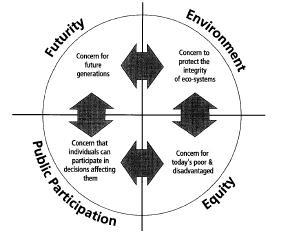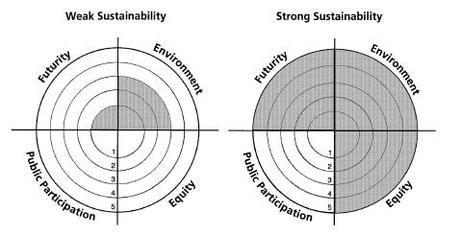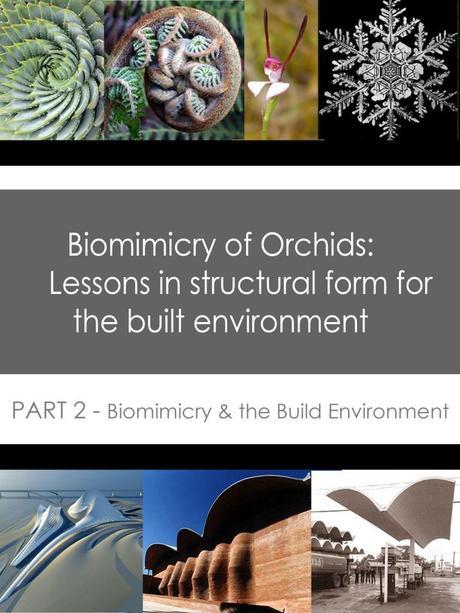
Biomimicry of Orchids: Lessons in structural form for the built environment
Keywords: Biomimicry, Computer-Aided Design, Orchids, Structural Efficiency
Joshua Anthony O’Meara 2010
Deakin University, Geelong, Australia
Supervisor: Sambit Datta
NOTE: This Thesis is the intellectual property of Joshua Anthony O’Meara. Any use of it’s content requires prior written consent by the Author.
PART 1 – Introduction & Sustainability
ABSTRACT:
The form of an object is a direct representation of the forces by which it has been subjected; forces both internal and external. As forms in nature, like those of the built environment, are subject both to the limitations of the materials strength and external forces such as gravity, lessons from nature are often applicable to the built environment, providing useful insights into new techniques for advancements in structural efficiency. The philosophy of biomimicry has significant potential in the structural realm, whereby rather than simply copying the forms of nature which can be problematic due to scales of magnitude, the true profundities are believed to come from an improved understanding of how nature and its forms work. Orchids are the specific focus of this study as the diverse and varied forms often overcome external forces through a manipulation of form. To resist force through form, rather than ‘the awkward accumulation of matter,’ is the core by which structural efficiency is founded. The thesis provides a general overview into the aspects of; sustainability; biomimicry; structural efficiency; the developments and opportunities presented by material and computer-aided design advancements, as well as researching the forms developed by the great structural artists such as; Antoni Gaudi; Eduardo Torroja; Eladio Dieste and Felix Candella. A variety of orchid forms were selected and analysed, and the findings are presented as common structural techniques and forms seen throughout a number of the orchid species. It was found that many of the orchid forms share similarities with those of the structural artists, although the great diversity of forms presents new techniques which could have exciting implications on the next generation of structures.
Keywords: Biomimicry, Computer-Aided Design, Orchids, Structural Efficiency
INTRODUCTION
“Certain modern artists and engineers are making more and more specific use of light structures which resemble, in form, shells and other elements of nature. These forms, some of which are warped, are obviously going to play an increasingly important role in the future. We cannot continue to construct our cities limiting ourselves to edifices exactly like boxes, exclusively inspired by the systems of the slab and the pillar. In the continuous evolution of modern architecture, it is more than likely that Gaudi’s last experiments will acquire increasing value and will be more fully appreciated. Then his importance as a pioneer and a prophet will be acknowledged.” Jose Luis Sert (1955) (Descharnes 1971:15)
Sustainability is unequivocally the most pressing issue of our time. The recently emerging philosophy of biomimicry represents a highly plausible guideline for humanity to address sustainable development, through innovation, guided by wisdom. A guiding principle of biomimicry is the idea of ‘tapping the power of limits.’ This principle is pertinent for the purpose of this thesis, as this is also the core principle by which structural artists discover their genius. Furthermore, it is apparent that structures in nature, are subject to the same forces as the built environment, and thus the idea of applying the philosophy of biomimicry to structural innovation could provide great insight. Forms in nature are derived from the forces by which they are or have been subjected. In contrast, the built environment tends towards pre-determined forms such as flat planes, which due to their inefficiencies are compensated through mass or the addition of supporting members. In this regard, architect Antoni Gaudi was well before his time. Gaudi looked to nature as his mentor, and his building forms, like nature were derived from the forces acting upon them. Through the intelligent use of form, Gaudi provided resistance to the acting forces, subjecting his materials to high levels of force within their capabilities achieving great structural efficiency.
Structural efficiency is important not only economically, but is also critical in creating more sustainable designs. As evident in the work of Gaudi as well as other structural artists such as Torroja, Dieste and Candella, structurally efficient forms, in following the laws of nature tend to result in elegant and beautiful forms. This thesis, whilst not of a mathematical or technical nature, explores structural principles and the influence of form on structural efficiency. The thesis provides a general overview of sustainability, biomimicry, structural efficiency and the various innovations of the aforementioned masters. The research then explores the forms of nature, specifically orchids, to analyze their curves for structural merit, discovering new forms which could become applicable in the built environment. The success of structural artists relies on their development of economical solutions that are easily constructed, for example, through the use of straight-line generators. As computer-aided design and manufacturing continue to advance, the possibility of forms with greater complexity will be made increasingly feasible and therefore lessons from nature increasingly applicable.
1. SUSTAINABILITY AND THE ORIGINS OF BIOMIMICRY
1.1. Sustainability
Sustainability and sustainable development are terms both used widely today, but as Palmer (1997: pp.87) argues, both lack any overall consensus, and thus their meanings are lost under ambiguities between different parties. Whilst the term is understood in its generality, the holistic nature of the term lends it to favour different priorities for different people. The environment has always been at the core of sustainability, championed by the ecology movement, although over time its definition has been broadened to place a greater focus on humanity which had been historically absent in the ecology movements priorities. The ecology movement might argue that the relationship between humanity and the environment is intrinsic and thus by caring for the environment they are indirectly caring for humanity. Nonetheless, the definition of sustainability has become more explicit in its human focus, as Gordon Mitchell et al. highlights (Palmer 1997: pp.88). Major literatures on the subject have considered sustainability to also encompass the principles of; Futurity; Equity and Public Participation.

Fig. 1 The four principles of Sustainability. Source: (Palmer 1997: pp. 88) reproduced from Gordon Mitchell et al. (1995)
Today sustainability is often used interchangeably with sustainable development, despite some critics such as David Pearce (Palmer: pp.87) arguing that the latter is an oxymoron. This alternate use between the two has no doubt affected the general understanding of the terms and has perhaps contributed to the meaning of sustainability being broadened. The most widely used definition for Sustainable development comes from Dr. Gro Harlem Brundtland, defined as “development that meets the needs of the present without compromising the ability of future generations to meet their own needs.” This definition introduces the generality of sustainability, although remains rather vague and some assumptions must be made. Despite being weak the definition does introduces the first principle; futurity. Another principle recognised to have growing importance to sustainability is that of equity. In an age of nuclear armaments, the importance of peace is significant to both humanity and the future of the planet. The Friends of the Earth Scotland (Palmer: pp.90) recognize that in a finite planet, with finite resources, greater equity is pivotal to maintaining peace. The last principle; Public Participation came from the Rio Declaration on Environment and Development (UNCED, 1992) and recognises the fundamental necessity for all to be involved in our quest towards sustainability. The four principles recognised by Mitchell are intrinsically linked and are all critical in our path towards sustainability. Palmer has devised a scale, to aid people or organisations to make clear their position or understanding of the term, as to avoid miscommunication. For the purpose of this thesis, any reference to sustainability will be in regard to environmental management and environmental degradation as fig. 2 indicates the authors weighting. Whilst the author appreciates that these principles are all important and intrinsically linked, reference to equity and public participation will be made apparent through the use of alternate words.

Fig.2 Authors stance on the use of the term sustainability
1.2. Context
There is a growing concern that we are fast approaching or have already surpassed the limits to which our planet can sustain (Enrlich 1997: pp. 153). The stress on our planet has been driven by a minority, in which 20 per cent of the world’s population consume 80 per cent of the world’s resources (Enrlich 1997: pp. 157). The rapid development of the remaining 80 per cent of the world’s population is believed by Murphy et al.(1997: pp. 173) and Watson (Woodruffs 2008: quoted in China: from red to green) to be the potential tipping point for the future of humanity. As Enrlich (1997) highlights, this is of real concern, as ‘the poor plan and aspire to consume as the rich do.’ Compounding these problems is a growing population projected to expand to 9.2 billion people by 2050 (Population Division 2007: pp. vii). Benyus (1996: pp. 251) highlights that the human enterprise functions as a Type I species, also known as an opportunist, whereby the species sprouts to makes the most of abundance, but soon after the boom,Type I species follow bust. She explains that in the past when depleting an eco-system, humanity could expand to virgin land and thus the opportunist was supported. The difference now, she argues, is that for the first time in history few virgin lands remain (Benyus 1996: pp. 251) and the poor are often already subjected to marginal lands. It is clear that humanity needs a new paradigm if it is to realize sustainability and comfortable living conditions for all. The direction we should take is widely debated and two prevalent schools of though have emerged over the past decades.
1.3. Schools of Thought
The first school of thought, accepts the idea of natural limits, placing emphasis on a critical assessment between needs and wants and thus advocating against consumerism and the capitalist mentality. In this view, society needs to reprioritise its values, leading to a cultural shift, with a focus on ‘the simple life’ and supported by the use of low-technological solutions. This school of thought has been championed by philosophers such as Mohandas Gandhi (1869-1948), and Henry David Thoreau (1817-1862) (Avery 2007: pp.85-94). Williams (1974: pp. 181) highlights the challenge, that to follow this path ‘we would be the first human society to impose a purposeful self-discipline,’ which is in direct opposition to the persuading tide of capitalism. The competing school of thought is founded on a deep faith for technology and human innovation to overcome all obstacles, championing commerce as ‘the driver of change.’ (Woodruff 2008: McDonough quoted in China: from red to green). According to Faucheux and O’Conner ‘the conflict between advocates of weak sustainability and of strong sustainability is founded…on a divergence in the confidence placed in technical change’ (Palmer et.al 1997: pp. 81). This appears to be a plausible assessment. Those who have the utmost faith in technology are unlikely to accept the notion of natural limits, as historically, innovation has shown that these can be overcome. This faith in innovation therefore justifies a reluctance to take responsibility or change poor habits. The danger of this mentality, as Einstein pointed out, is that ‘a problem cannot be solved by the same amount of thought which created it’ (French 1988: pp. 247), and thus it appears a dangerous game as humanity continues to distance itself further from nature and challenges continue to surmount. A recently emerging philosophy growing significant support is Biomimicry. Biomimicry combines the fundamental aspects of the two schools of thoughts promoting innovation as an inevitable player towards sustainability, although an underlying wisdom remains at the core, calling for humanity to establish a more humble position on our planet.
1.4. Origins of Biomimicry
‘Unlike the Industrial Revolution, the Biomimicry Revolution introduces an era based not on what we can extract from nature, but on what we can learn from her (Benyus 1996: pp. 2).’
Biomimicry is defined as follows;
BI – O – MIM – IC – RY
[From the Greek bios, life, and mimesis, imitation]
- Nature as model. Biomimicry is a new science that studies nature’s models and then imitates or takes inspiration from these designs and processes to solve human problems, e.g., a solar cell inspired by a leaf.
- Nature as measure. Biomimicry uses an ecological standard to judge the “rightness” of our innovations. After 3.8 billion years of evolution, nature has learned: What works. What is appropriate. What lasts.
- Nature as mentor. Biomimicry is a new way of viewing and valuing nature. It introduces an era based not on what we can extract from the natural world, but on what we can learn from it.
(Benyus 1996: preface)
Whilst the idea of taking inspiration from nature as our guide is far from new, as quite pertinently expressed by Leonardo da Vinci (1452-1519) many hundreds of years ago, stating that “those who take for their standard any one but nature-the mistress of all masters-weary themselves in vain,” (Vezzosi 1997: pp.138, originally from Codex Atlanticus) the growing interest and discoveries in biology continues to expand our appreciation for nature. Biomimicry is the premise that nature represents a blueprint to survival, as Darwin had earlier alluded in his hypothesis; ‘survival of the fittest.‘ Over millions of years, nature has evolved and the species that exist today are the champions of survival. As Benyus (1996: pp. 4) states these survivors have been ‘imaginative by necessity’, having already ‘solved the problems we are struggling to solve.’ Nature as model, measure and mentor, firstly lays impetus on our path towards sustainability through innovation. Secondly it calls for humanity to consider nature and its harmonious closed-loop systems. How do things relate and thus how can we relate? Lastly, biomimicry demands from us, greater respect for nature. Humanity can no longer consider nature and its limits at odds to our aspirations, but they must be seen as one and the same. Benyus suggests, the time is now, that ‘we adapt to the earth rather than the other way around’ (1997: pp. 7). Biomimicry also calls for greater efforts to safeguard nature’s creations, for obvious reasons. Benyus warns of ‘the very real possibility of losing a quarter of all species in the next thirty years (Benyus 1997: pp. 9). In our quest towards sustainability Biomimicry appears likely to play a growing role in all facets, but particularly the built environment.
CLICK BELOW To Continue reading BIOMIMICRY OF ORCHIDS – PART 2 – Biomimicry & the Built Form


